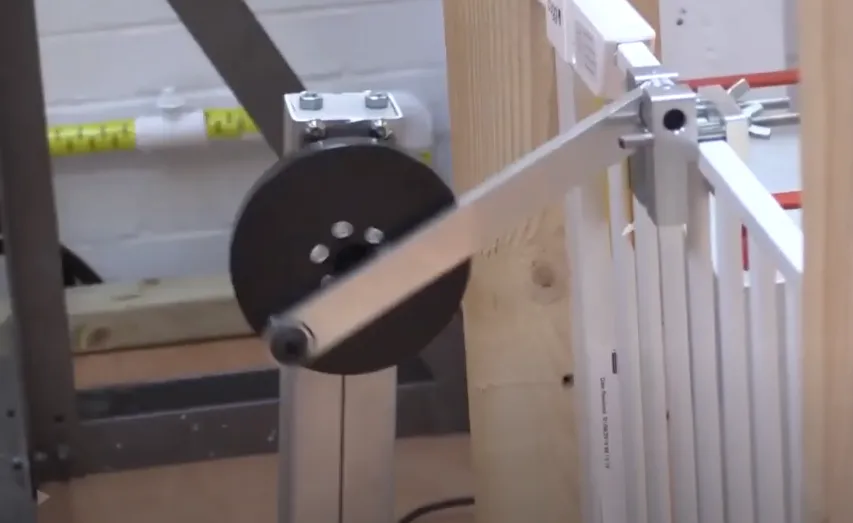ASTM F2085 Portable Bed Rails Safety Testing
The ASTM F2085 standard is specifically designed to ensure that portable bed rails used in children’s furniture meet safety requirements. This testing ensures the structural integrity, durability, and safe design of these rail systems, which are often used in cribs, play yards, or other types of children's beds.
The primary focus of ASTM F2085 is to prevent accidental entrapment and suffocation, as well as to ensure that the rails do not detach or break under normal use. These portable bedrails must withstand a variety of mechanical stress tests to demonstrate their ability to protect young children from harm. This service ensures that manufacturers adhere strictly to these standards, thereby protecting the health and safety of infants and children.
Testing typically involves several key parameters, including static load testing, impact testing, durability testing, and detachment resistance tests. The static load test checks whether the rail can support a specified weight without collapsing or failing. Impact testing assesses how well the rail resists forces that could be applied during an accidental fall or impact.
The ASTM F2085 standard also specifies acceptance criteria for these tests. For instance, the rail must not show any visible signs of damage after being subjected to a static load equivalent to more than twice the weight it is expected to support. Impact testing requires that the rail withstand several impacts without detaching or breaking.
Proper specimen preparation is crucial in ASTM F2085 testing. Specimens are typically selected based on their intended use and size, ensuring they accurately represent real-world conditions. This process ensures consistent results across all tests conducted under this standard.
| Test Type | Description |
|---|---|
| Static Load Test | Tests the rail's ability to support a specified weight without failing. |
| Impact Testing | Evaluates resistance to forces that could be applied during an accidental fall or impact. |
| Durability Testing | Makes sure the rail can withstand repeated stress over time without failing. |
| Detachment Resistance Test | Ensures that the rail does not detach from its mounting points under normal use. |
The testing process involves rigorous quality control measures to ensure accuracy and reliability. Our team of experts uses advanced instrumentation to measure force, displacement, and other critical parameters during each test. This precision is essential for providing accurate results that can be relied upon by manufacturers and regulatory bodies.
Our laboratory adheres strictly to ASTM F2085, ensuring that all tests are conducted in compliance with the latest standards. By partnering with us, you can rest assured that your products will meet or exceed safety requirements, thus protecting children's health and well-being.
Applied Standards
- ASTM F2085-19: Standard Test Method for Determining the Performance of Portable Bed Rails in Children’s Furniture
The ASTM F2085 standard provides a comprehensive framework for evaluating portable bed rails used in children's furniture. This test method covers various aspects, including static load testing, impact testing, durability testing, and detachment resistance tests.
Static Load Testing: This test evaluates the rail’s ability to support a specified weight without collapsing or failing. The standard specifies that the rail must not show any visible signs of damage under this condition.
Impact Testing: This assessment checks how well the rail resists forces that could be applied during an accidental fall or impact. It ensures that the rail remains intact and does not detach from its mounting points.
Durability Testing: This test confirms that the rail can withstand repeated stress over time without failing. The standard requires that the rail must not show any visible signs of damage after being subjected to a static load equivalent to more than twice the weight it is expected to support.
Detachment Resistance Test: This test ensures that the rail does not detach from its mounting points under normal use. It checks for secure attachment and prevents accidental detachment, which could lead to serious harm.
Benefits
The ASTM F2085 standard is crucial in ensuring that portable bedrails used in children's furniture meet safety requirements. This testing guarantees the structural integrity, durability, and safe design of these rail systems, which are often used in cribs, play yards, or other types of children’s beds.
One significant benefit of this service is the prevention of accidental entrapment and suffocation. The tests ensure that the rails do not collapse under normal use conditions, reducing the risk of a child becoming trapped between the rail and the mattress. This feature provides peace of mind to parents and caregivers, knowing that their children are safe while sleeping or playing.
Another advantage is the durability and longevity of the products tested. By adhering strictly to ASTM F2085 standards, manufacturers can produce high-quality products that last longer and remain safe for extended periods. This ensures a consistent level of safety across all models and batches produced by the manufacturer.
The testing process also helps ensure compliance with relevant regulations and guidelines. By meeting these requirements, companies avoid potential legal issues and maintain their reputation as responsible manufacturers committed to protecting children's health and well-being.
Moreover, ASTM F2085 testing enhances product performance and reliability. Rigorous testing ensures that the rail systems are robust and dependable, providing consistent protection against accidental falls and other hazards. This leads to improved overall safety for children using these products.
In summary, this service offers numerous benefits, including enhanced safety, durability, compliance with regulations, and improved product performance. These advantages contribute significantly to creating a safer environment for young children, promoting trust among consumers, and supporting responsible manufacturing practices.





